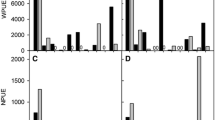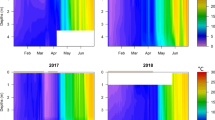Abstract
We present a comparative study on the occurrence of spring clear-water phases in six eutrophic lakes (two deep, four very shallow lakes dominated by plankton, TP: 0.06–0.13 mg l-1) in the Scharmützelsee region (Germany). Our aim was to analyse the occurrence and intensity of clear-water phases in relation to shallowness and trophic state. We defined a clear-water phase by a continuous increase of Secchi depth, a corresponding decrease in algal biomass and a shift in phytoplankton species composition during the growth phase of cladoceran zooplankton. For shallow lakes, we used the increase of the euphotic depth up to maximum depth as an additional criterion. Only in two of six lakes a clear-water phase occurred. In two lakes, no spring peak of cladocerans developed. In two other lakes, a high biomass of grazing resistant cyanobacteria was not affected by cladoceran maxima. Daphnia galeatawas an important component of the grazer community in lakes with a clear-water phase, whereas lakes without a clear-water phase were dominated by Bosmina longirostris. Top-down control of grazing by fish predation is discussed as the main factor determining biomass, composition and timing of the cladoceran spring peak. The assumed relative strength of fish predation between lakes corresponds to the response in algal biomass, dominance of cyanobacteria and is inversely related to the potential grazing pressure (ratio of cladoceran and algal biomass). Bottom-up effects (food quality) and additional factors (fungal infection, flushing rate) may also influence growth and timing of cladocerans. Our results support the view that a high biomass of grazing zooplankton is essential for the occurrence of a clear-water phase, but not sufficient to explain variability between lakes. High cladoceran maxima in hypertrophic lakes indicate that food quality seems not to limit grazer biomass. Decoupling of zooplankton and phytoplankton may be the result of early and fast growth of grazing resistant algae. We conclude that shallowness and trophy may indirectly reduce the extent and predictibility of a clear-water phase by enhanced growth of cyanobacteria and increasing predation pressure at least for lakes on this TP level.
Similar content being viewed by others
References
Adrian, R., R. Deneke, U. Mischke, R. Stellmacher & P. Lederer, 1995. A long-term study of the Heiligensee (1975–1992). Evidence for effects of climatic change on the dynamics of eutrophied lake ecosystems. Arch. Hydrobiol. 133: 315–337.
Arndt, H. & B. Nixdorf, 1991. Spring clear-water phase in a eutrophic lake: control by herbivorous zooplankton enhanced by grazing on components of the microbial web. Verh. int. Ver. Limnol. 24: 879–883.
Arndt, H., M. Krocker, B. Nixdorf & A. Köhler, 1993. Long-term annual and seasonal changes of meta-and proto-zooplankton in Lake Müggelsee (Berlin): effects of eutrophication, grazing activities and the impact of predation. Int. Rev. ges. Hydrobiol. 78: 379–402.
Arp, W., 1997. Ein methodischer Ansatz zur Planktonuntersuchung am Beispiel Berliner und Brandenburger Gewässer. Dissertation. Technical University Berlin: 187 pp.
Balvay, G., M. Gawler & J. P. Pelletier, 1990. Lake trophic status and the development of the clear-water phase in lake Geneva. In Tilzer M. M. & C. Serruya (eds), Large Lakes. Springer Verlag, Berlin: 580–591.
Behrendt, H. & B. Nixdorf, 1993. The carbon balance of phytoplankton production and loss processes based on in situ measurements in a shallow lake. Int. Rev. ges. Hydrobiol. 78: 439–458.
Benndorf, J., 1995. Possibilities and limits for controlling eutrophication by biomanipulation. Int. Rev. ges. Hydrobiol. 80: 519–534.
Brooks, J. L. & S. I. Dodson, 1965. Predation, body size and composition of plankton. Science 150: 28–35.
DeMott, W. R., & W. C. Kerfoot, 1982. Competition among cladocerans: nature of the interaction between Bosminaand Daphnia. Ecology 63: 1949–1966.
Deneke, R., A. Kleeberg, R. Hämmerling & B. Nixdorf, 1998. Trophiestatus und Bewertung der Seen im Scharmützelseegebiet (Brandenburg) im Zeitraum 1994–97 als Grundlage für die Erarbeitung von Restaurierungsmaßnahmen. In A. Trautmann (ed), Internationale Seen-Fachtagung 1998 – Aktionsprogramm zur Sanierung oberschwäbischer Seen. Oberschwäbische Verlagsanstalt, Ravensburg: 295–306. Deutsche Einheitsverfahren zur Wasser-, Abwasser-und Schlammuntersuchung, 1986–1996. Verlag Chemie GmbH, Weinheim.
Edmondson, W. T., 1960. Reproductive rates of rotifers in natural populations. Mem. Ist. ital. Idrobiol. 12: 21–77.
Elser, J. J. & C. R. Goldman, 1991. Zooplankton effects on phytoplankton in lakes of contrasting trophic status. Limnol. Oceanogr. 36: 64–90.
Flößner, D., 1972. Krebstiere, Crustacea. Kiemen-und Blattfüßer, Branchiopoda. Fischläuse, Branchiura. In Dahl F. (Begr.), M. Dahl & F. Peus, (Hrsg.), Die Tierwelt Deutschlands. 60.Teil. Gustav Fischer Verlag, Jena.
Flößner, D. & K. Kraus, 1986. On the taxonomy of the Daphnia hyalina-galeatacomplex (Crustacea: Cladocera). Hydrobiologia 137: 97–115.
Gliwicz, Z. M. & W. Lampert, 1990. Food thresholds in Daphniaspecies in the absence and presence of blue-green filaments. Ecology 71: 691–702.
Hanazato, T. & M. Yasuno, 1985. Effect of temperature in the laboratory studies on growth, egg development and first parturition of five species of Cladocera. Jap. J. Limnol. 46: 185–191.
Jeppesen, E., J. P. Jensen, M. Søndergaard, T. Lauridsen, L. J. Pedersen & L. Jensen, 1997. Top-down control in freshwater lakes: the role of nutrient state, submerged macrophytes and water depth. Hydrobiologia 342/343: 151–164.
Lampert, W., 1987. Laboratory studies on zooplanktoncyanobacteria interactions. New Zealand J. mar. Freshwat. Res. 21: 483–490.
Lampert, W., 1988. The relative importance of food limitation and predation in the saesonal cycle of two Daphniaspecies. Verh. int. Ver. Limnol. 23: 713–718.
Lampert, W. & U. Schober, 1978. Das regelmäßige Auftreten von Frühjahrsalgenmaximum und ‘Klarwasserstadium’ im Bodensee als Folge von klimatischen Bedingungen undWechselwirkungen zwischen Phyto-und Zooplankton. Arch. Hydrobiol. 82: 364–386.
Lampert, W., W. Fleckner, H. Rai & B. E. Taylor, 1986. Phytoplankton control by grazing zooplankton: a study on the spring clear-water phase. Limnol. Oceanogr. 31: 478–490.
LeCren, E. D. & R. H. Lowe-McConnell, 1980. The functioning of freshwater ecosystems. Cambridge University Press, Cambridge.
Lehman, J. T., 1980. Release and cycling of nutrients between planktonic algae and herbivores. Limnol. Oceanogr. 25: 620–632.
Luecke, C., M. J. Vanni, J. J. Magnuson & J. F. Kitchell, 1990. Seasonal regulation of Daphniapopulations by planktivorous fish implications for the spring clear-water phase. Limnol. Oceanogr. 35: 1718–1733.
Lynch, M., 1980. Aphanizomenonblooms: alternate control and cultivation by Daphnia pulex. In Kerfoot W. C. (ed.), Evolution and Ecology of Zooplankton Communities. University Press of New England, Hanover: 299–304.
Markager, S., B. Hansen & M. Søndergaard, 1994. Pelagic carbon metabolism in a eutrophic lake during clear-water phase. J. Plankton Res. 16: 1247–1267.
Meijer, M.-L., E. Jeppesen, E. Van Donk, B. Moss, M. Scheffer, E. Lammens, E. Van Nes, J. A. Van Berkum, G. J. de Jong, B. A. Faafeng & J. P. Jensen, 1994. Long-term responses to fishstock reduction in small shallow lakes: interpretation of five-year results of four biomanipulation cases in The Netherlands and Denmark. Hydrobiologia 275/276: 457–466.
Müller-Navarra, D. C., S. Güss & H. von Storch, 1997. Interannual variability of seasonal succession events in a temperate lake and its relation to temperature variability. Global Change Biology 3: 429–438.
Nicklisch, A., 1999. Competition between the cyanobacterium Limnothrix redekeiand some spring species of diatoms under P-limitation. Internat. Rev. Hydrobiol. 84: 233–241.
Nixdorf, B & A. Liepelt, 1996. Lichtklima der Gewässer. In Nixdorf B. & A. Kleeberg (eds), Gewässerreport Scharmützelseegebiet, Teil II (in german). BTU Cottbus AR 2: 22–28.
Nixdorf, B. & R. Deneke, 1997. Why ‘very shallow’ lakes are more successful opposing reduced nutrient loads. Hydrobiologia 342/343: 269–284.
OECD, 1982. Eutrophication of waters. OECD report, Paris.
Porter, K. G., 1976. Enhancement of algal growth and productivity by grazing zooplankton. Science 192: 1332–1334.
Reynolds, C. S., 1984. The ecology of freshwater phytoplankton. Cambridge University Press, Cambridge.
Rott, E., 1981. Some results from phytoplankton counting intercalibrations. Schweiz. Z. Hydrol. 43: 34–62.
Sarnelle, O., 1993. Herbivory effects on phytoplankton succession in a eutrophic lake. Ecol. Monogr. 63: 129–149.
Sas, H., 1989. Lake restoration by reduction of nutrient loading – Expectations, Experiences, Extrapolations. Academia Verlag Richard: 497 pp.
Scheffer, M. & E. Jeppesen, 1998. Alternative stable states. In Jeppesen E., M. Søndergaard, M. Søndergaard & K. Christoffersen (eds), The Structuring Role of Submerged Macrophytes in Lakes. Springer-Verlag, New York: 397–406.
Scheffer, M., S. Rinaldi, Y. A. Kuznetsov & E. H. Van Nes, 1997. Seasonal dynamics of Daphniaand algae explained as a periodically forced predator-prey system. Oikos 80: 519–532.
Schmitt, M. & B. Nixdorf, 1999. Spring phytoplankton dynamics in a shallow eutrophic lake. Hydrobiologia 408/409: 269–276.
Sommer, U., Z. M. Gliwicz, W. Lampert & A. Duncan, 1986. The PEG-model of seasonal succession of planktonic events in fresh waters. Arch. Hydrobiol. 106: 433–471.
Sterner, R. W., 1989. The Role of Grazers in Phytoplankton Succession. In Sommer U. (ed.), Plankton Ecology: Succession in Plankton Communities. Springer Verlag, Berlin: 107–170.
Utermöhl, H., 1958. Zur Vervollkommnung der quantitativen Phytoplanktonmethodik. Mitt. int. Ver. Limnol. 9: 1–38.
Wiedner, C. & B. Nixdorf, 1998. Success of chrysophytes, chryptophytes and dinoflagellates over blue-greens (cyanobacteria) during an extreme winter (1995/96) in eutrophic shallow lakes. Hydrobiologia 369/370: 229–235.
Willén, E., 1976. A simplified method of phytoplankton counting. Br. phytocol. J. 11: 265–278.
Author information
Authors and Affiliations
Rights and permissions
About this article
Cite this article
Deneke, R., Nixdorf, B. On the occurrence of clear-water phases in relation to shallowness and trophic state: a comparative study. Hydrobiologia 408, 251–262 (1999). https://doi.org/10.1023/A:1017088008761
Issue Date:
DOI: https://doi.org/10.1023/A:1017088008761




